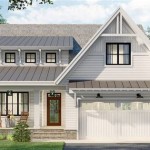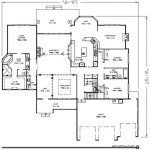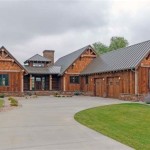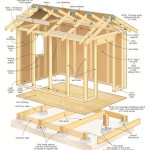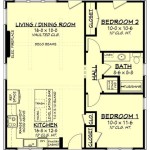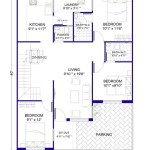```html
20 X 24 Garage Plans: A Comprehensive Guide
The selection of a garage plan represents a significant decision for homeowners and property developers alike. A 20 x 24 garage, offering 480 square feet of floor space, provides a versatile solution for various needs, ranging from vehicle storage and workshop utilization to potential conversion opportunities. This article delves into the considerations, advantages, and key aspects of 20 x 24 garage plans, offering a comprehensive overview for those contemplating such a structure.
Space Optimization and Versatility
One of the primary benefits of a 20 x 24 garage lies in its balanced dimensions. The relatively generous floor area allows for the comfortable parking of a standard-sized vehicle while still providing ample room for storage shelves, tool benches, or other workspace requirements. This configuration distinguishes it from smaller single-car garages, which often lack sufficient space for anything beyond vehicular accommodation. The 20-foot width provides adequate clearance for opening vehicle doors and maneuvering around the interior, enhancing usability.
The 24-foot depth further contributes to the versatility of the space. This allows for the installation of workbenches along the back wall, the storage of longer items such as lumber or recreational equipment, and even the potential for a small utility area or half-bathroom. The depth also makes it more adaptable for future conversions should the owner decide to repurpose the garage into a workshop, hobby room, or even an accessory dwelling unit (ADU), subject to local zoning regulations.
Moreover, a 20 x 24 garage can be designed with various door configurations to optimize access and functionality. A single, wider garage door may be preferred for ease of vehicle entry and exit. Alternatively, two single-car garage doors can be incorporated, providing separate access points for different vehicles or activities. The placement and size of personnel doors, also known as pedestrian doors, are equally important considerations, impacting the flow of traffic and the overall convenience of the garage.
Structural Considerations and Design Options
The structural integrity of a 20 x 24 garage is paramount, requiring careful consideration of foundation type, wall construction, and roof design. The choice of foundation will typically depend on soil conditions, local climate, and budget constraints. Common foundation options include a concrete slab, a perimeter foundation with a gravel base, or a full basement foundation.
A concrete slab is a cost-effective and relatively simple option, providing a solid and level surface for the garage. However, it offers limited protection against moisture and may not be suitable for areas prone to flooding. A perimeter foundation involves constructing a concrete wall around the perimeter of the garage, filled with compacted gravel. This provides better drainage and can raise the floor level slightly, mitigating moisture issues. A full basement foundation offers the most comprehensive protection and provides significant additional storage or living space, but it is also the most expensive option.
Wall construction typically involves either wood framing or concrete block. Wood framing is a popular choice due to its cost-effectiveness, ease of construction, and availability of materials. However, it is susceptible to rot and insect damage if not properly treated. Concrete block offers greater durability and resistance to fire and pests but requires specialized skills for installation. Other wall materials, such as steel framing or insulated concrete forms (ICF), may also be considered, depending on specific requirements and budget.
Roof design plays a crucial role in both the aesthetics and structural integrity of the garage. Common roof styles include gable, hip, and shed roofs. A gable roof, characterized by its triangular shape, is a classic and cost-effective option. A hip roof, with its sloping sides, offers greater resistance to wind and snow. A shed roof, with its single sloping plane, is a simple and modern option, often used for detached garages or garages attached to the side of a house. The roof pitch, or slope, should be carefully selected to ensure adequate drainage and structural stability.
Permitting and Regulatory Compliance
Before commencing construction of a 20 x 24 garage, it is essential to obtain the necessary permits and ensure compliance with local building codes and zoning regulations. These regulations vary significantly depending on the location and may cover aspects such as setbacks from property lines, maximum building height, allowable square footage, and drainage requirements.
The permitting process typically involves submitting detailed plans and specifications to the local building department for review. The plans should include information about the foundation, framing, roofing, electrical, and plumbing systems. The building department will assess the plans to ensure they meet the minimum safety standards and comply with all applicable regulations. Failure to obtain the required permits can result in fines, delays, and even the demolition of the structure.
Zoning regulations may also dictate the permitted uses of the garage. For example, some jurisdictions may prohibit the use of a garage as a permanent dwelling unit or restrict the operation of certain types of businesses within a residential garage. It is crucial to research and understand these regulations before finalizing the design and intended use of the garage. Consulting with a local architect, contractor, or building official can help navigate the permitting process and ensure compliance with all applicable regulations.
Furthermore, it's important to consider any homeowner's association (HOA) rules that might apply. HOAs often have architectural guidelines that dictate the appearance of new structures, including garages. These guidelines might specify acceptable roofing materials, siding colors, and overall design aesthetics. Failure to comply with HOA rules can lead to fines and legal disputes.
Cost Estimation and Budgeting
The cost of constructing a 20 x 24 garage can vary significantly depending on several factors, including the complexity of the design, the choice of materials, the site conditions, and the labor costs in the local area. It is essential to develop a detailed budget that accounts for all potential expenses, including materials, labor, permits, and contingency funds.
Material costs will typically represent a significant portion of the overall budget. This includes the cost of concrete, lumber, roofing materials, siding, doors, windows, electrical wiring, and plumbing fixtures. Obtaining multiple quotes from different suppliers can help ensure competitive pricing. Consider the long-term durability and maintenance requirements of different materials when making your selection.
Labor costs will also have a substantial impact on the overall budget. Hiring a general contractor to oversee the entire project can provide peace of mind and ensure quality workmanship. However, this will also increase the overall cost. Alternatively, homeowners may choose to act as their own general contractor and hire subcontractors for specific tasks, such as framing, roofing, and electrical work. This can potentially save money but requires significant time and effort.
Permit fees can vary widely depending on the jurisdiction and the scope of the project. It is essential to factor these fees into the budget to avoid unexpected expenses. Additionally, it is prudent to set aside a contingency fund to cover unforeseen costs, such as unexpected site conditions or material price increases. A general rule of thumb is to allocate 10-15% of the total budget for contingency.
Future Considerations and Potential Enhancements
When planning a 20 x 24 garage, it's wise to consider future needs and potential enhancements. This could include provisions for electrical vehicle (EV) charging, improved insulation for energy efficiency, or the addition of a loft or second story for extra storage or living space. Planning for these future enhancements during the initial design phase can often be more cost-effective than retrofitting later.
Adding electrical outlets and circuits specifically for EV charging is a forward-thinking investment that can increase the value and utility of the garage. This involves installing a dedicated circuit with a higher amperage capacity than standard outlets, as well as a suitable charging station. Similarly, incorporating energy-efficient insulation in the walls, roof, and foundation can significantly reduce heating and cooling costs, particularly if the garage is used as a workshop or hobby space.
The addition of a loft or second story can dramatically increase the storage capacity of the garage or even provide the opportunity for a separate living space, such as an office or guest room. This requires careful planning and structural design, as it adds significant weight and complexity to the structure. However, it can be a worthwhile investment for those who need additional space and are willing to invest in a more substantial project.
Finally, consider the aesthetic integration of the garage with the existing house and landscaping. Choosing complementary siding materials, roofing styles, and paint colors can enhance the overall curb appeal of the property. Landscaping around the garage can also help blend it into the surroundings and create a more visually appealing environment.
```
2 Car Garage With Storage Plan 720 1 24 X 30 By Behm Design

24x30 Garage Plans Bing Images

24 X 30 E Z Garage Plan Home Designing Service Ltd

24x30 2 Car 1 Door Detached Garage Plans Design Blueprints

30x24 2 Car Garage 720 Sq Ft 12ft Walls Floor Plan Instant Model 10j

24x30 Garage Plans Hip Roof 30 X24 Print 2 Car 17 2430 1

Garage Plan G3024v

Building Plans For Two Car Garage Plan 247

Extended 2 Car Apartment Garage Plan 1440 1apt

H576 1 24 X 30 Behm Design

